When the pandemic closed schools in March 2020, Piedmont City Schools didn’t have to scramble to purchase laptops. The system didn’t have to figure out how to get their students internet access. It didn’t have to digitize its course materials.
Piedmont did those things a decade ago, gaining national recognition and accolades.
But Piedmont also knew, thanks to their digital experience, that teaching through technology takes preparation and practice and can lead to a declining performance if relied on too heavily.
And ultimately, Piedmont has learned the connection that matters most is not the internet connection; it’s the connection between student and teacher and student and the school. As soon as they could safely reopen, they did.
“There is no substitute for face-to-face learning no matter how versed you are in delivering digital instruction,” said Piedmont Superintendent Mike Hayes.
Results of Alabama’s new standardized test, the Alabama Comprehensive Assessment Program (ACAP), provide evidence that Piedmont’s experience and approach helped its students excel. Piedmont students outscored state averages in math and reading at every grade level.
Figure 1. Percentage of students proficient as measured by ACAP math and English language arts assessments, 2021, Grades 3-8, Piedmont vs. State of Alabama average
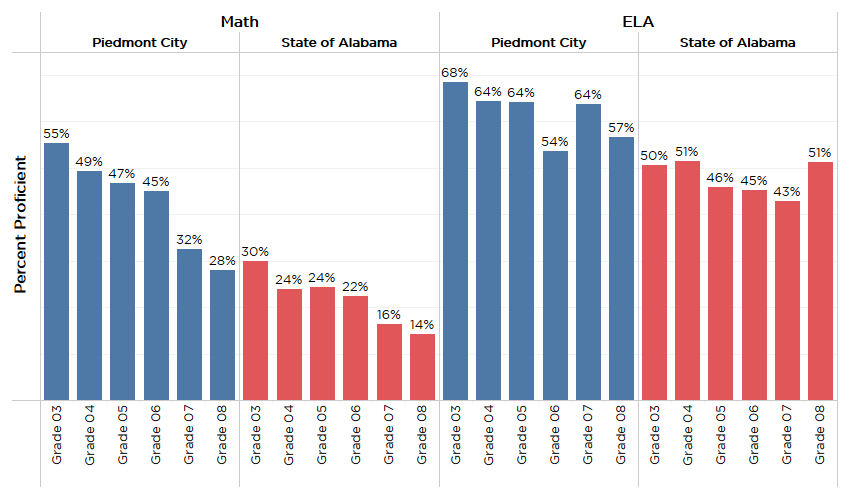
Piedmont’s performance is even more impressive when the student body’s level of economic disadvantage is considered. On average, students from economically disadvantaged households score lower on standardized tests than students from more affluent backgrounds. The percentage of Piedmont students qualifying for a free lunch under the National School Lunch Program is almost 10 percentage points higher than the state average. Figure 2. compares two factors: the percentage of students proficient on the ACAP test and the percentage of students directly qualify for the school lunch program. School systems above the line of prediction in the graph are exceeding the level of performance expected based on their level of poverty. Piedmont’s proficiency level far exceeds the performance of schools with similar demographics.
Figure 2. Percentage of Students Proficient on 2021 ACAP vs. Percentage of Students Economically Disadvantaged, by System
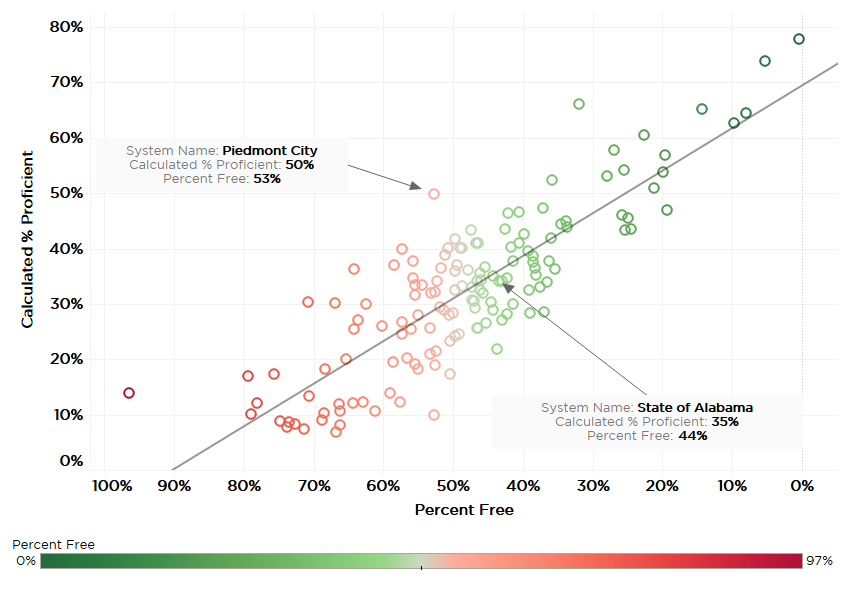
Across the country, there is a great deal of interest in the impact of educational changes made in emergency response to the pandemic, including the sudden switch to online instruction.
Preliminary data from across the country indicates that student academic progress lagged significantly behind pre-pandemic norms. The sudden shift to digital instruction and remote learning will be examined as one of the factors contributing to that missed learning. At the same time, though, it’s clear that aspects of virtual learning will endure, making it all the more important to understand digital instruction’s strengths and weaknesses.
So, what does Piedmont’s experience teach about the promise and pitfalls of digital education?
First, that educational innovation and excellence can happen anywhere. When then-Superintendent Matt Akin started pursuing the idea of handing each student a laptop, it seemed an unlikely dream. But in 2010, Piedmont, a small, underfunded district (106 in funding out of 138 school systems in 2019) in a town of about 4,400 in rural Northeast Alabama, became the first system in the state to provide all students in grades 4-12 with an Apple laptop computer. Eventually, all teachers were trained and Apple Certified, many traveling to Palo Alto and connecting cutting-edge educators around the country.
Figure 3. Percentage of students directly qualifying for the National Free Lunch Program, Piedmont vs. State of Alabama
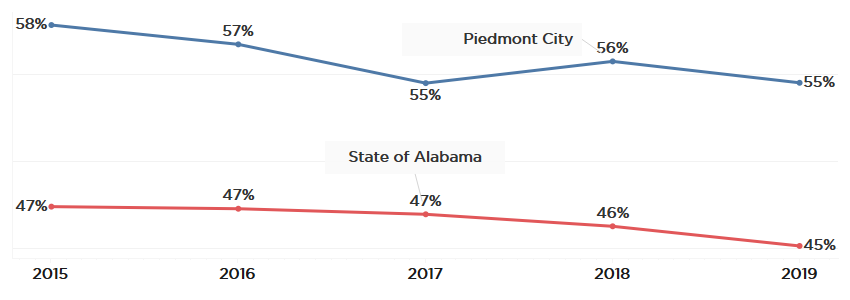
The district was an original and continuing member of the nationwide League of Innovative Schools, a network that aims to “design, validate, champion, and scale effective, innovative learning opportunities to advance equity and excellence for every student.”
Piedmont City Schools even became a broadband provider, cooperating with community leaders and business partners to identify the best ways to get students connected to the Internet.
Akin’s successor, Hayes, said the system’s digital revolution was transformative and continues to pay dividends. However, the distribution of laptops was only the beginning of a much longer journey, a journey that is ongoing.
The technology didn’t produce overnight results. Along the way, there were disappointments and drift and continual course corrections. “We didn’t have a blueprint to follow. It was like we were building the plane while it was in the air,” he said.
Among the lesson learned:
- Digital resources are tools that can supplement and accelerate learning, allowing struggling students to keep up and advanced students to excel. Data gleaned from digital assessment tools provide teachers powerful insight if the data is systematically and consistently reviewed and instruction targeted to meet all student’s needs.
- However, if digital delivery is leaned on too heavily, if the local teacher doesn’t remain the central guide and shepherd of the instruction, students can fall by the wayside. Quality and engagement can suffer.
- Most fundamentally, in Piedmont’s experience, the road to the future circled back to the tried and true: Good teachers and relationships make the difference.
Over time, Piedmont has produced results to be proud of. In a system where the poverty percentage is ten points higher than the state average, proficiency levels are consistently higher than the state’s as a whole.
Figure 4. Piedmont vs. State, Aspire & Scantron, Grades 3-8
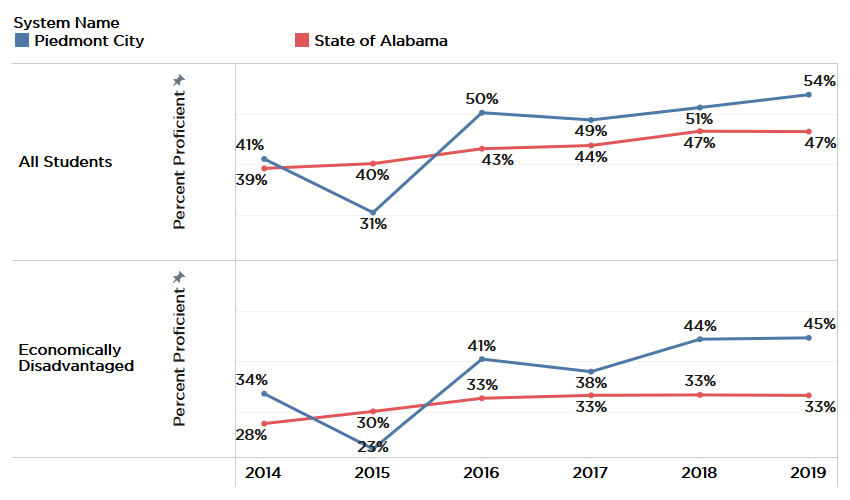
Piedmont’s ACT scores for all students trail the state average, though that’s not unexpected considering the disproportionate number of economically-disadvantaged students at Piedmont. When comparing those economically-disadvantaged students to other economically disadvantaged students across the state, Piedmont students outperform.
Figure 5. Average Composite ACT for economically-disadvantaged students, Piedmont vs. State of Alabama
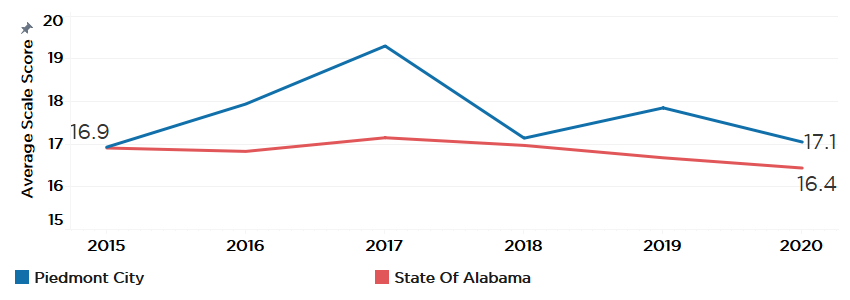
And Piedmont graduates nearly all of its seniors on time and having met the state’s definition of college and career-ready.
Figure 6. Graduation and College/Career Readiness Rates, Piedmont vs. State of Alabama, 2018-2020
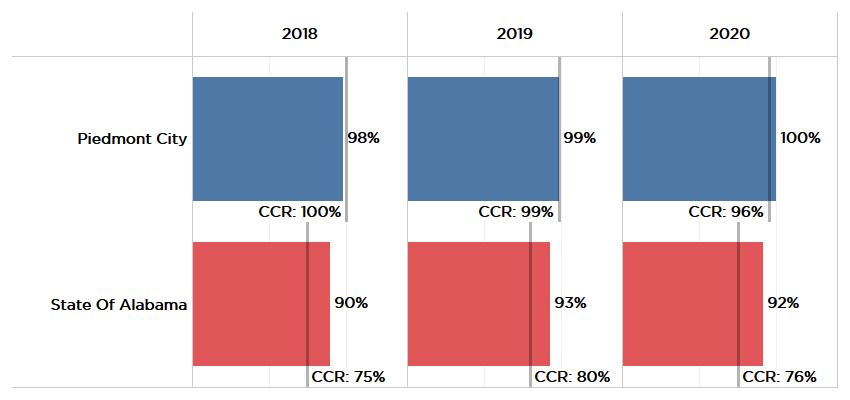
What Piedmont learned about digital learning
Passing out laptops to school kids may have garnered attention back in 2010, but that was just the beginning of an ongoing journey in discovering how technology can enhance the educational experience and when it has the potential to interfere.
Don’t let the technology distract from the mission
When Piedmont first launched its technology initiative, it tried to create its own broadband network in cooperation with the city and an Alabama-based technology company. The City of Piedmont happened to have installed fiber optic cable throughout town, but it wasn’t being used. Taking advantage of that infrastructure, the school system and its partners launched a citywide wireless network.
But soon, it became apparent that it was unworkable to run a school system while also managing a small Internet provider utility, providing the necessary service and support.
Meanwhile, Piedmont had developed an alternative. Though it’s a small city system, Piedmont allows students from nearby rural systems, in Calhoun, Cherokee, Cleburne, and Etowah counties, to attend tuition free, due to its open enrollment policy. To provide Internet service to those students, they worked out a deal with Verizon for cellular data hot spots. Eventually, the system worked out a way to provide that same solution for the students who needed it in town.
Hayes said that solution might not work for other rural areas, but the rural areas around Piedmont’s happen to be well-served by Verizon cellular since more sizable towns (Jacksonville, Anniston, Gadsden, and Rome, Ga.) are not too far away.
The long and the short of it: Don’t let technology maintenance become a distraction; always seek simpler solutions.
Don’t lean too heavily on online resources; teachers are still key
With the wealth of online resources out there, you could point students to good resources and allow them to set their own learning courses. That’s part of the promise of digital education.
But in Piedmont’s experience, the local classroom teacher still needs to set the course for learning and guide the group through the material.
When material is presented in a passive digital form, it is not always well absorbed.
“Kids tend to watch, but they don’t necessarily process and synthesize,” Hayes said. “They need to be taking notes.”
“In the beginning, it was a challenge to find the sweet spot between digital and traditional curriculum,” said Hayes. “We quickly realized the teacher has to be the driving force in the classroom, with whole group instruction remaining a prominent part of the curriculum.”
Teachers divide class time between whole group instruction, small group instruction, and independent work. There is still time for advanced students to work ahead independently, while others who need more individualized instruction receive it. But Piedmont found that with too much unstructured time, students drifted.
“You lose students when you give them too much independent work on the computer,” Hayes said. “Or when they can plug in or choose answers without showing their work.”
Multiple choice computer programs don’t record a student’s path toward an answer.
So, Piedmont brought some tangible and tactile work back. That includes math and vocabulary notebooks. When students write material down and show their steps, a teacher can better understand the student’s thought process, and, if they ended up with the wrong answer, the teacher can identify where the student went wrong. Building a physical catalog of vocabulary seems to increase retention and create a sense of pride and ownership.
Clearly, digital tools are powerful—both for students and for teachers. Computer-based formative assessments, for example, can be of great value. They can create a much more detailed picture of what a student knows and where they are struggling.
But once you have that data, you need a structured plan for putting that data to use.
In Piedmont, teachers monitor data throughout and come together every four weeks to evaluate it on a full day devoted to data.
Elementary teachers meet by grade level. Middle School and High school meet by department. The teams analyze the data and devise instructional plans for the next four weeks, taking into consideration what students have successfully mastered and which standards need additional reinforcement.
“Our instruction is changing every four weeks,” Hayes said.
Cultivate your teachers and help them to continue to learn and grow
Because it highly values the classroom teacher, Piedmont has built a teacher cultivation process that starts in high school and continues throughout a teacher’s career.
Rural systems have a hard time attracting and retaining teachers.
To address this, Piedmont attempts to grow its own teachers by identifying kids in high school who show signs of interest and ability. With support and guidance from the school system, those students can find scholarships and other aid to get them into and through nearby Jacksonville State University’s School of Education. The locally-connected teachers are more likely to be invested in the Piedmont community and are more willing to stay for the long term, reducing turnover.
Once they’re on the faculty, they have ongoing opportunities to grow. The connections to the national educational technology world provide avenues for travel and training. And the system also incentivizes teachers to pursue National Board Certification, increasing their salaries and improving their classroom practice.
According to Hayes, Piedmont has the state’s highest percentage of board-certified teachers in its system and ranks No. 3 nationally, with 35% of the faculty having earned the certification.
In addition to the pay differential, National Board-Certified teachers are given two additional personal days and one additional professional development day to devote to maintaining their certification.
The system also provides continuous professional feedback to teachers between the school and central office staff; each teacher is observed teaching monthly.
Education is a relationship
For all its promise, technology can’t replace relationships. Being a small rural system may present challenges, but it also helps in keeping an eye on students as individuals. Piedmont doesn’t just rely on its small-town nature to make this happen. The intimacy is systematically cultivated.
Every Thursday, students in grades 4-12 are divided into groups of about a dozen students who meet with an individual faculty member assigned to that particular team of kids. There is a technological aspect to this. The teacher mentor maintains a Google spreadsheet for each kid, and through it, gets feedback and grades on each of the kids from their teachers and coaches. They monitor their students’ grades, attendance, and performance across subjects. The technology puts the mentor in the position to ask questions before problems get too serious: Why are your grades slipping? What are these absences? What is going on?
Most importantly, the mentor teachers build long-term relationships and 360 degree understanding of the students. That creates a unified point of accountability, based on a personal relationship between student and teacher, and also, when possible, with parents.
That may help explain why Piedmont has graduated close to 100% of its seniors on time for several years running.
When faced with a potential dropout, Hayes said, “We pull all resources at our disposal together and develop a plan to ensure the student continues on a path to graduation.”
Having learned the importance of relationships and face-to-face accountability, Piedmont went back to in-person schooling as soon as they safely could during the 2020-2021 school year, while observing all the safety protocols.
Despite that, 30 to 35% of high school students and 10% of the younger kids chose remote learning. The system allowed and supported that. However, they required virtual students to come to school twice a month for in-person check-ins. And if a student’s average falls below a 70 in a class, they were required to come back to school unless they had a special circumstance like being immune-compromised or having an immune-compromised family member.
Aiming for the Future
In launching its technology initiative a decade ago, Piedmont hoped to keep students more interested and engaged. That may help explain why the system’s graduation and career readiness rates are among the highest in the state. While the engagement with technology may have something to do with, the more obvious source of that success is the system’s longer-term methodical preparation of students.
Recognizing the importance of the ACT when it comes to college entrance and scholarships, Piedmont starts early. The Piedmont team has realized that a critical hurdle to success on the ACT involves vocabulary. The vocabulary and sentence structure of the exam is college level, but it is being given to 11th graders, many of whom are first-generation college students.
So, the system focuses on vocabulary building throughout elementary and secondary education, with students consistently challenged to learn new words.
Throughout high school, teachers are encouraged to create ACT-type questions for their regular tests. An ACT prep class is required for all juniors. And students are encouraged to take the ACT as many times as possible, which often results in improved scores.
According to Hayes, those scores mean something. A 26 on the ACT puts a student in the running for a substantial scholarship at Jacksonville State University, with even more generous scholarship benefits available to those who score higher.
College-bound or not, the high school offers students instruction in etiquette and soft skills. Every student is required to set up a Linked-In Account, develop a resume, and fill out the Free Application for Federal Student Aid (FAFSA).
Piedmont’s Career Tech educational offerings aren’t broad, but they start early, and are aligned with the needs of local employers, and, thus, offer opportunities for work placement. Also, an additional requirement – that each student do at least some community service –serves to engage students in the real needs of the community.
Conclusion
Piedmont’s bold work with technology has undoubtedly benefited students in a world that is increasingly reliant on technology for educational delivery. At the same time though, Piedmont recognizes that technology can become a distraction if not utilized thoughtfully. To provide a complete education, you need teachers, well trained and open to growth and adaptation. You need students motivated to learn and engaged by the school and community. You need a destination and a methodical approach to getting there.
